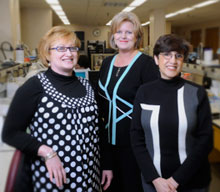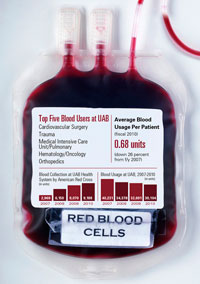Collections Up, Usage Down at UAB
 |
Donna Salzman, Sherry Polhill, and Marisa Marques explain how new transfusion protocols have helped make UAB Hospital an example for centers around the country. |
In the last decade, hospitals have realized that the best way to use blood is very carefully. At a major emergency and trauma center such as UAB, however, the demands for blood transfusions—for accident victims, patients recovering from surgery, and dozens of other uses—are constant.
Until 2007, blood use at UAB Hospital seemed to be on a permanent upward trajectory, with annual usage reaching 40,231 units, the hospital’s highest total ever. That same year, the hospital started widespread educational efforts to instruct staff on new transfusion protocols. The new protocols were a response to studies demonstrating that patients often benefit the most when they are given less transfused blood.
By the end of fiscal year 2010, annual usage at the hospital had dropped to 30,104 units—and UAB became an example for centers around the country. At the same time, increased promotional efforts led to a marked increase in blood donations, with collections rising about 300 percent. “We’re the poster child, both in terms of improved blood utilization and blood collections,” says Donna Salzman, M.D., co-chair of the UAB Blood Utilization and Management Committee.
Physicians and staff have accepted and adopted the new way of working, Salzman says, particularly in the critical care units, cardiovascular services, and trauma service.
 |
Click on the image above to enlarge. |
Blood by the Numbers
Before new transfusion protocols were in place, “we were using on average 770 units a week, or 110 a day,” says Marisa B. Marques, M.D., Salzman’s co-chair on the committee. In fiscal year 2010, which ended September 30, “we used on average 582 units a week,” she says—a decrease of more than 24 percent.
Because the number of patients seen fluctuates from year to year—as does the number of blood-intensive trauma cases—a more meaningful measure of UAB’s success is the decline in average units of blood used per patient at discharge. “When we started this project, on average just about every single person who entered the hospital got a unit of blood,” Salzman says. “The transfusion-to-discharge ratio was 0.9, and now it is 0.68.”
In fact, “UAB Hospital has not had any blood shortages since we began increasing our collections and reducing our utilization,” says Laboratory Administrative Director Sherry R. Polhill, MT, M.B.A., who is responsible for blood collections at UAB.
Reduced blood usage means less blood needs to be collected, Salzman says, and it also reduces expenses for the hospital. The next step is to incorporate the new protocols at UAB Highlands, she adds. Then staff will turn their attention to the other two blood components commonly used in hospitals: platelets and plasma.
—Tara Hulen